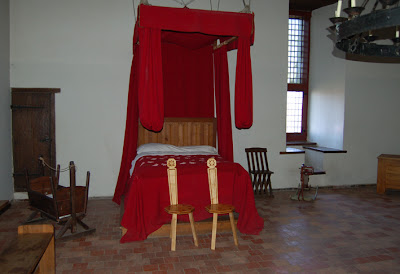At the Loevestein event we only had some 'special' medieval food during the opening hours. We enjoyed it ourselves, but also shared it with the visitors. I had made some 'caliscioni' - a kind of almond cookies with rose water and a 'torta bianca' - a cake with cream cheese and again rose water. I also made a tiered dried fruit pie for the first time. It tasted great and will certainly be included in our favourite medieval dishes list. All the mentioned recipes came from the book 'The medieval kitchen - recipes from France and Italy' by Odile Redon, Francoise Sabban and Silvano Serventi, which is in itself a collection of 13-14th century recipes from other sources (ISBN 0226706850).
Below I will give the recipe of the Tiered dried fruit pie or Torta in balconata. The original source is the Libro di Cucina del secolo XIV by Ludovico Frato:
Tiered torta for twelve persons. Take the whitest flour you can get, three libre in quantity, and take two ouncie of sugar and take a libra of almonds, and thirty-six good walnuts, and half a libra of raisins, and twenty-five dates, and half a quarto of cloves; and take a good quantity of almond milk; take the flour, mpistened with water to make it very thick, and take the pan and grease it well with oil; make a crust from the flour with crushed sugar and the aforementioned spices; take the walnuts, then the chopped dates and well-washed raisins, and the red cloves; and put a crust between each layer; and put a crust on top of all these things to make a torta. [English translation of original text].
To make it more simple:
For the pate brisee (the dough for the crust): 450 gram flour, 200 gram butter, 2/3 cup water, a teaspoon salt.
For the almond milk: 150 gram blanched almonds, 1 litre warm water.
For the filling: 25 gram sugar, 75 gram raisins, 1/3 teaspoon ground cloves, 18 shelled walnuts, 13 dates.
Cut the butter in small pieces and rub it through the flour until the mixture has the consistency of sawdust. Dissolve the salt in half of the water and add to the flour mixture. Combine quickly with your fingertips until the dough comes together. If necessary add more water. Wrap in plastic and refrigerate for at least 2 hours before using.
Make the almond milk: Put the blanched almonds and half of the warm water together in a grinder and grind for several minutes. Put the mixture through a strainer with a double layer of cheese cloth and use the almond grit with the other half of the warm water to grind again for some minutes in the grinder. Also put this through the strainer with the cheese cloth. The almond milk will be more than you will need for the torta.
Preheat the oven to 220 degrees Celsius. Divide the dough into three parts. Roll the first into a circle large enough to line a 22 cm tart pan. On your work surface sprinkle the pastry with some of the sugar and the cloves and press them into the dough with the rolling pin. Line the tart pan and arrange the walnuts on the sugared pastry. Sprinkle liberally with almond milk. Divide the second third of the dough into two and roll each into a thin circle that will fit into the tart. Sprinkle with sugar and cloves, and press them into the dough. Place this on top of the walnuts. Coarsely chop the dates and arrange them on top op the dough; sprinkle liberally with almond milk. Roll out and sugar the other half of the dough as before and place it on top of the dates. Arrange the raisins on top of this layer and sprinkle liberally with almond milk. Roll out the remaining dough and cover the pie, sealing the edges well. bake for at least an hour.
According to the authors, medieval doctors viewed this type of food as the healthiest kind, because it is full of dried fruits, therefore having great strengthening qualities. Indeed our youngest child had suffered from a cold and recovered quickly in the days after...
Because the torta is very solid, you need only serve a small portion. It is particularly apt for winter meals; this is also when the best dried fruits from the previous season are available.
































